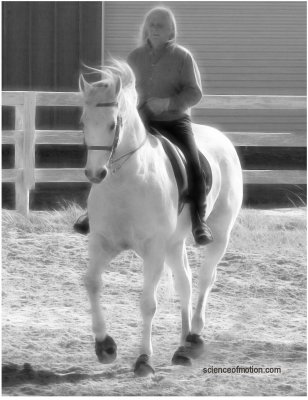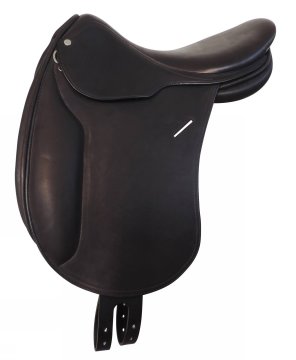Riding the Samba Macel Saddle
Riding the Samba
(Macel Dressage Saddle)
“The last saddle you will ever need”.
Jean Luc Cornille

Lateral bending occurs between T16 and T9. Transversal rotations are situated between T14 and T9. Basically, lateral bending and axial rotations occur between the rider’s upper thighs. With the tree narrowing under the rider’ upper thighs and the clever design of the pads in contact with the horse back, the Macel Samba allows precise and study contact of the rider’s upper thighs. This is what attracted me when the Samba was first designed in 1968. Classical schools teach descending the thighs toward the vertical, but to do so, one has to fight the saddle as most saddles encourage instead sitting on the gluts and squeezing the lower thighs.
When, succumbing to fashion, saddles started to swell enormous knee pads, abysmal deep seat and thick paddings, Macel’s Patrick Fesquet preserved the pertinent design of the Samba, adding superb leather quality and craftsmanship. Lateral bending and associated rotation of the horse thoracic spine occurs between the rider’s upper thighs and therefore are stimulated by the rider’s upper thighs. Properly balanced over the seat bones and therefore the ASIS (Anterior Superior Iliac Spine), slightly advanced between the forearms, the rider can gently hug the horse’s thoracic dorsal spines and surrounding muscles between the upper thighs, The upper thighs is the highest part of the thighs, from the pelvis one third down to the thighs. Facing right or facing left, the rider can easily bend the horse’s thoracic spine. However, riding is about physics and not posture. Bending the horse’s thoracic spine between the upper thighs is the only way to really bend the horse’s thoracic vertebrae, but it is a dynamic concept.
First, the rider needs to be in neutral balance over the seat bones, which means, the body weight is not acting back to front or front to back. The seat bones are the lower part of the pelvis and are just two points. The stability is ensured by the gluts situated behind and the muscles of the upper thighs, situated ahead. The rider is then constantly over the gluts, the seat bones and the upper thighs. Stability over the seat bone is then ensured by adjustments between the gluts and the upper thigh. Deep seat saddles are pushing the rider’s seat bones forward encouraging the rider in having more weight on the gluts. The pelvis angle changes, lifting the thighs. The rider tries then finding stability squeezing the lower thighs initiating a series of damaging reactions. Enormous knee pads, and in some saddles pads in front of the rider’s thighs, are theoretically designed to ensure proper legs position. They are in fact aggravating the problem as knees and upper thighs are pushing up against the pads.
Squeezing the lower thighs creates too much tension on the upper thighs as well as abdominal muscles. Harmonic tensegrity, verses relaxation, force anatomy verses functional anatomy, are expressions upgrading old language to actual knowledge. It is all about forces, energy, and the real harmony between the rider and the horse is not the amplitude of movement, but instead about harmonic tensegrity. Excessive tension of the upper thighs and abdominal muscles is not only going to alter the subtle motion of the rider’s vertebral column, but also the harmony between the horse and the rider tensegrity. Gross anatomy and gross equitation still promote an equitation of gestures to sell enormous knee pads, but the horse natural subtlety is much more refined than these gross theories and the horse does have to protect himself from excessive tension as well as excessive motion.
Squeezing the lower thighs also induces squeezing the knees which places the rider’s lower legs, the calves, away from the horse’s belly. The negative effects are considerable. In her 2002 study on humans and animals “Umwelt” C. A. Saslow discovered a very high tactile perception in the area of the horse’s body in contact with the rider’s legs. “Using stimuli developed for gauging human tactile sensitivity, we were surprised to find that horse sensitivity on the parts of the body which would be in contact with the rider’s legs is greater than what has been found for the adult human calf or even the more sensitive human fingertip. Horses can react to pressures that are too light for the human to feel. This raise the possibility that human instability on the saddle result in inadvertent delivery of irrelevant tactile signals to the horse and consequent failure in teaching the horse which signal is meaningful.” As squeezing the lower thighs moves the rider calves away from the horse flanks, riders ensure legs contact squeezing the calves, delivering tactile signals above the horse’s comfort zone. Even worse are the moving legs touching or even hitting the horse flanks repetitively. Saslow wrote later in her study, “Horses deemed insensitive to the leg, (dead-sided) may simply never had the chance to respond to consistent, light, meaningful signals.”
The stability of the rider’s seat depends on the ability of sustaining a study and light contact of the upper thighs, a gentle hug. From seat stability come the capacity of sustaining soft contact with the calf on the horse flank. The dialogue with the legs can then be limited to subtle nuances in muscle tone. Without neutral balance over the seat bones and gentle hug of the upper thighs, subtle equitation cannot be reached.
One branch of the science of motion approach is rehabilitation through motion. Our approach to kissing spine is that we regard kissing spine as a muscular issue. Our therapy focusses on identifying and correcting back muscle imbalance or dysfunction causing intermittent contact of the dorsal spines. The rate of success is very high. The few cases which did not work, were conscious or subconscious resistance of the rider in evolving from a traditional seat placing the weight on the gluts, to a seat effectively in neutral balance over the seat bones. Deep seat saddles and swelled knee pads were in the way to efficient riding. Rehabilitating a horse through exercise therapy is as efficient for the equine as for humans. However, it is more difficult rehabilitating a horse than riding a horse in the show ring. If talented enough, a horse will perform well in spite of dysfunction. Once the dysfunction has created pathological damages, the rehabilitation does not tolerate any dysfunction. This is where the rider and the horse need a good seat and a saddle allowing a good seat. The science of motion’s perception of a good saddle is not a saddle fitting the horse standing still, but a saddle fitting the horse in motion.
Science Of Motion is the offical distribitor for Macel Samba in USA and Canada
For information on purchasing saddle contact Helyn helyn@scienceofmotion.com
706-816-7259
Special order options: This saddle may be ordered with other seat sizes, 3 tree sizes, 3 colors and 3 flap lengths, at no additional charge. Sizes from 16 to 18 1/2 Comfort of the seat can be constructed for individual need. Price is same as price you would get from France.
Made In France
"Conceived in tradition and perfected with time, Macel Saddles are hand crafted in France and desired globally. Macel's meticulous attention to detail, right down to a single stitch, is their mark of excellence."
Maintaining production on one site, with each saddle produced by one craftsman ensures intimate knowledge and total control over the quality of the final product.
French saddlery is the result of traditional craftsmanship which is envied throughout the world. It is crucial to preserver it, to protect its secrets and above all to resist the temptation of cheaper outsourcing.
Special order options: This saddle may be ordered with other seat sizes, 3 tree sizes, 3 colors and flap lengths, at no additional charge.
Contact Helyn helyn@scienceofmotion.com for more information and to order.
706-816-7259


 twitter
twitter facebook
facebook pinterest
pinterest linkedin
linkedin